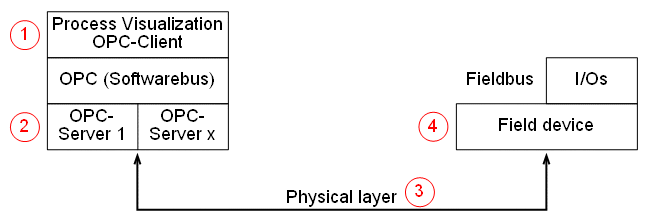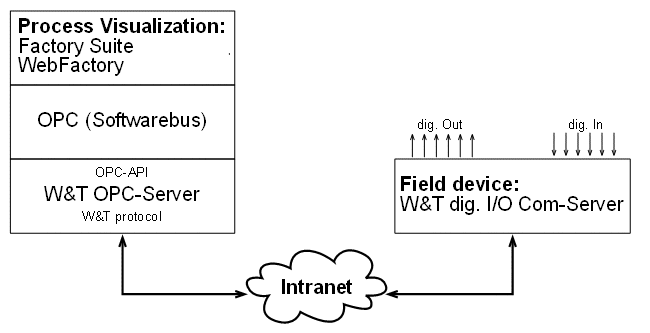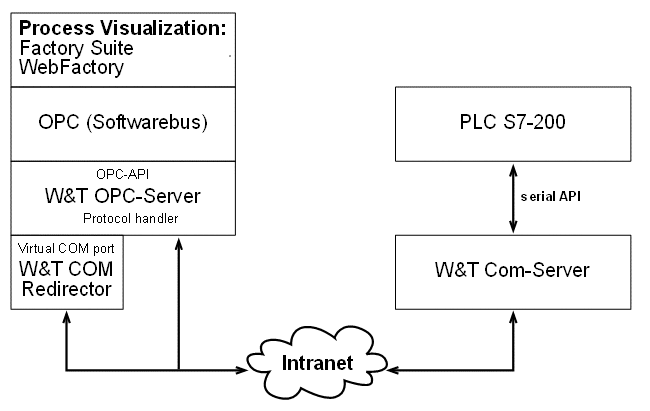Application for the serial Com-Server:
Com-Server and automation technology
Visualization systems of various manufacturers have established themselves as standard solutions in the field of automation. They provide MMIs (man-machine interfaces). In order to remain independent of the many brand-specific protocols, most visualization systems use OPC (OLE for Process Control) technology for the transfer of data to and from the field level.
As shown in the diagram, the OPC server works as a gateway application. Towards the application, it provides a standardized OPC software interface, which makes I/O data available in the form of items. Towards the lower level, the values or contents of these items are detected by the OPC server by means of special protocols.

1 Windows applications (e.g. FactorySuite or WebFactory).
Reads/writes I/O values (=items) from/to the OPC server2 OPC server as software components from manufacturers of field devices, visualization systems or third-party suppliers. The OPC server provides OPC clients with I/O values in the form of items.
3 Ethernets are more and more replacing traditional RS232 and RS485 interfaces as the preferred transfer medium.
4 All devices such as PLCs, digital I/O Com-Servers, serial Com-Servers, etc.
What options are available with W&T Com-Servers in such systems?
The applications presented on this page will answer this question. The following application examples include the following visualization products, that are representative for all such systems:
- FactorySuite/InTouch by Wonderware
- WEBfactory by ecom WEBfactory GmbH.
Integration of remote I/O points
Via the intranet, remote I/O points can be integrated into process visualization systems. As most companies already avail of complex network structures, there is virtually no limit as regards the distance between the visualization console and the I/O point. The costs for cabling are minimal.

Integration of remote serial messages
In addition to digital I/O points, the W&T OPC server also supports the communication with devices that are linked by serial connection to the Com-Server. The processing of ASCII alarms, cyclic measured values and messages or even a control system for a display panel as shown in the following diagram can be implemented based on the process visualization.

Integration of remote control systems by means of standard protocols
Many network operators require the integration of remote devices with serial standard protocol communication into visualization systems or other applications. Obviously, the use of the already existing network infrastructure has again many advantages. Whether the tunneling of such serial protocols or an Ethernet with TCP/IP is possible depends mainly on the dimensioning of the timing. Due to its method for access to the medium and the hardly predicable network loads, Ethernet only fulfills "soft" requirements as regards real-time communication.
The following protocols have been successfully tunneled through Ethernets:
Siemens S7-200 PPI
Siemens Simatic 505
Siemens Tiway
Siemens S5 AS511
Modbus ASCII + RTU
HART
Others: Cutler Hammer D50/300, Fischer & Porter Micro-DCI, Idec Computer Link, Mitsubishi FX, Omron Host Link, Omron Process Suite, Partlow ASCII, Toshiba Computer Link
The integration is also here best achieved through OPC, whereby OPC servers supplied by the hardware provider or by a third company can be used. Depending on the functionalities of the OPC server, the physical connection is established directly via the socket interface (connecting parameter = IP address + port number) or indirectly via the W&T COM Redirector with virtual COM port.

Integration of remote devices with inherent protocols (e.g. Web Thermometer)
As Wonderware’s FactorySuite allows for the definition of own (simple) protocols, users have the option to integrate devices for which there is no suitable OPC server available into the visualization system. The following diagram shows such a solution for the W&T Web Thermometer. It operates the request/response method and returns the current temperature on request.
The definition of the protocol is limited to the following parameters:
- Polling frequency: suitable interval for the temperature queries, e.g. 30s
- Request sequence: sequence at which the request is carried out (.e.g. "GET/Single" for the Web Thermometer)
- Response sequence: type and format of the response
(e.g. current temperature, 6-byte ASCII string for the Web Thermometer)
